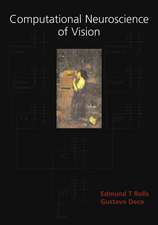Peptides in Neurobiology: Current Topics in Neurobiology
Editat de Harold Gaineren Limba Engleză Paperback – 11 noi 2011
Preț: 587.67 lei
Preț vechi: 691.38 lei
-15% Nou
Puncte Express: 882
Preț estimativ în valută:
112.47€ • 116.18$ • 93.60£
112.47€ • 116.18$ • 93.60£
Carte tipărită la comandă
Livrare economică 25 martie-08 aprilie
Preluare comenzi: 021 569.72.76
Specificații
ISBN-13: 9781461341321
ISBN-10: 1461341329
Pagini: 488
Ilustrații: XX, 464 p.
Dimensiuni: 155 x 235 x 26 mm
Greutate: 0.68 kg
Ediția:Softcover reprint of the original 1st ed. 1977
Editura: Springer Us
Colecția Springer
Seria Current Topics in Neurobiology
Locul publicării:New York, NY, United States
ISBN-10: 1461341329
Pagini: 488
Ilustrații: XX, 464 p.
Dimensiuni: 155 x 235 x 26 mm
Greutate: 0.68 kg
Ediția:Softcover reprint of the original 1st ed. 1977
Editura: Springer Us
Colecția Springer
Seria Current Topics in Neurobiology
Locul publicării:New York, NY, United States
Public țintă
ResearchCuprins
1 Peptides in Neurobiology: Historical Introduction.- 1. The Neurosecretory Neuron and the Concept of Neurosecretion.- 2. The Hypothalamic Origin of the Posterior Lobe Hormones.- 3. The Hypothalamic Control of the Adenohypophysis.- 4. Nonhormonal Neurosecretory Signals to Endocrine and Nonendocrine Effector Cells.- 5. Peptidergic Interneuronal Communication.- 6. Conclusion.- 7. References.- 2 Application of Fluorescent Techniques to the Study of Peptides.- 1. Introduction.- 2. Preparation of Materials and Equipment.- 3. Isolation of Peptides from Tissues.- 4. Separation and Detection of Peptides.- 5. Applications.- 6. Conclusion.- 7. References.- 3 Specific Problems in the Identification and Quantitation of Neuropeptides by Radioimmunoassay.- 1. Introduction.- 2. Radioimmunoassay for Detection of Well-Characterized Peptides in Nervous Tissues.- 3. Development of Radioimmunoassay Systems for Newly Described Peptides.- 4. Conclusions and Conjectures.- 5. References.- 4 Immunocytochemistry of Neuropeptides and Their Receptors.- 1. Introduction.- 2. The Unlabeled Antibody Enzyme Method—Sensitivity of Immunocytochemistry.- 3. Modifications of the Unlabeled Antibody Enzyme Method.- 4. Immunocytochemical Staining of Nervous Tissue.- 5. Neurotransmitter Pathways—Catecholamines and Serotonin.- 6. Hypothalamopituitary Pathways.- 7. Neuropeptide Receptors.- 8. Nonpituitary Neurosecretory Peptide Pathways.- 9. References.- 5 Substance P and Neurotensin.- 1. Introduction.- 2. Guidelines for the Isolation of Biologically Active Peptides.- 3. Guidelines for the Radioimmunoassay of Small Peptides.- 4. Substance P.- 5. Neurotensin.- 6. References.- 6 Biologically Active Peptides in the Mammalian Central Nervous System.- 1. Introduction.- 2. Historical Perspective.- 3. IndirectMethods for Locating Neurosecretory Cells.- 4. Regional Distribution of Selected Peptides.- 5. Conclusion.- 6. References.- 7 Peptides Containing Probable Transmitter Candidates in the Central Nervous System.- 1. General Properties of CNS Peptides.- 2. Peptide and Peptidoamine Synthesis with N-Terminal Acetyl-Asp.- 3. Factors That Affect the Levels and Release of Peptides in the CNS.- 4. A Working Hypothesis of Peptides as the Final Common Pathway of Multisignal Integration.- 5. Specific Examples of the Working Hypothesis.- 6. Conclusion.- 7. References.- 8 Biosynthesis of Neuronal Peptides.- 1. Introduction.- 2. The Precursor-Protein (Prohormone) Concept.- 3. Strategy for the Study of Peptide Biosynthesis in Neurons.- 4. Peptidergic Neurons in Aplysia as Model Systems.- 5. Biosynthesis of Neurohypophyseal Peptides and Neurophysin.- 6. Regulation of Neuronal Peptide Biosynthesis.- 7. Biological Significance of the Precursor Mode of Peptide Biosynthesis.- 8. Conclusion.- 9. References.- 9 Conversion and Inactivation of Neuropeptides.- 1. Introduction.- 2. Conversion of Prohormones.- 3. Inactivation of Active Peptides.- 4. References.- 10 Peptides in Invertebrate Nervous Systems.- 1. Introduction.- 2. Coelenterata.- 3. Arthropoda (Crustacea).- 4. Arthropoda (Insecta).- 5. Mollusca.- 6. Echinodermata: Radial Nerve Factor.- 7. Conclusion.- 8. References.- 11 Physiological Roles of Peptides in the Nervous System.- 1. Introduction.- 2. Substance P.- 3. Angiotensin II.- 4. Parvicellular Peptides: Thyrotropin-Releasing Hormone and Luteinizing Hormone—Releasing Hormone.- 5. Magnocellular Peptides: Antidiuretic Hormone (Lysine Vasopressin) and Oxytocin.- 6. Conclusions.- 7. References.- 12 Electrical Activity of Neurosecretory Terminals and Control of Peptide Hormone Release.-1. Introduction.- 2. The Crustacean X-Organ Sinus Gland Neurosecretory System.- 3. General Conclusions.- 4. References.- 13 Endogenous Opiate Peptides.- 1. Introduction.- 2. The Opiate Receptor.- 3. Adenylate Cyclase and the Mechanism of Addiction.- 4. Endogenous Opiates.- 5. Physiological Role of Endogenous Opiate Peptides.- 6. References.- 7. Addendum.- 8. Addendum References.- 14 Behavioral Effects of Peptides.- 1. Introduction.- 2. Implication of the Pituitary Gland in Acquisition and Maintenance of Conditioned Avoidance Behavior.- 3. Behaviorally Active Adrenocorticotropic Hormone Fragments.- 4. Behavioral Effects of Vasopressin and Congeners.- 5. General Discussion.- 6. References.






















